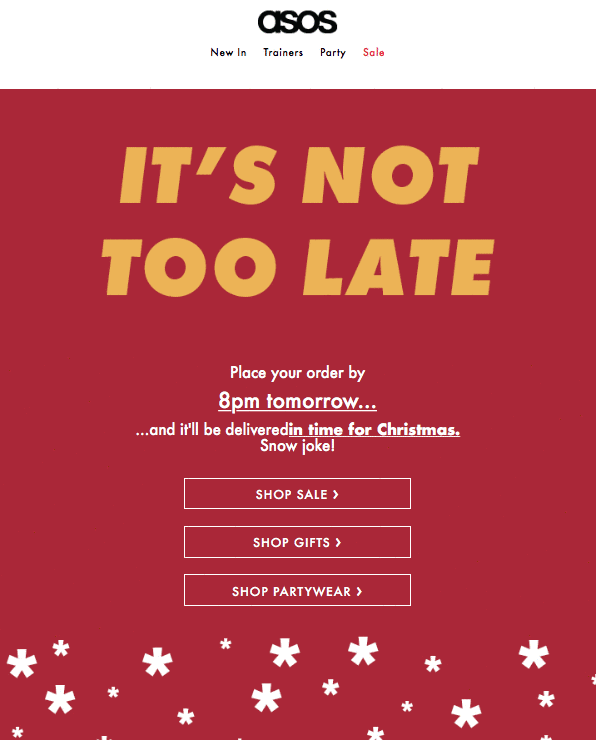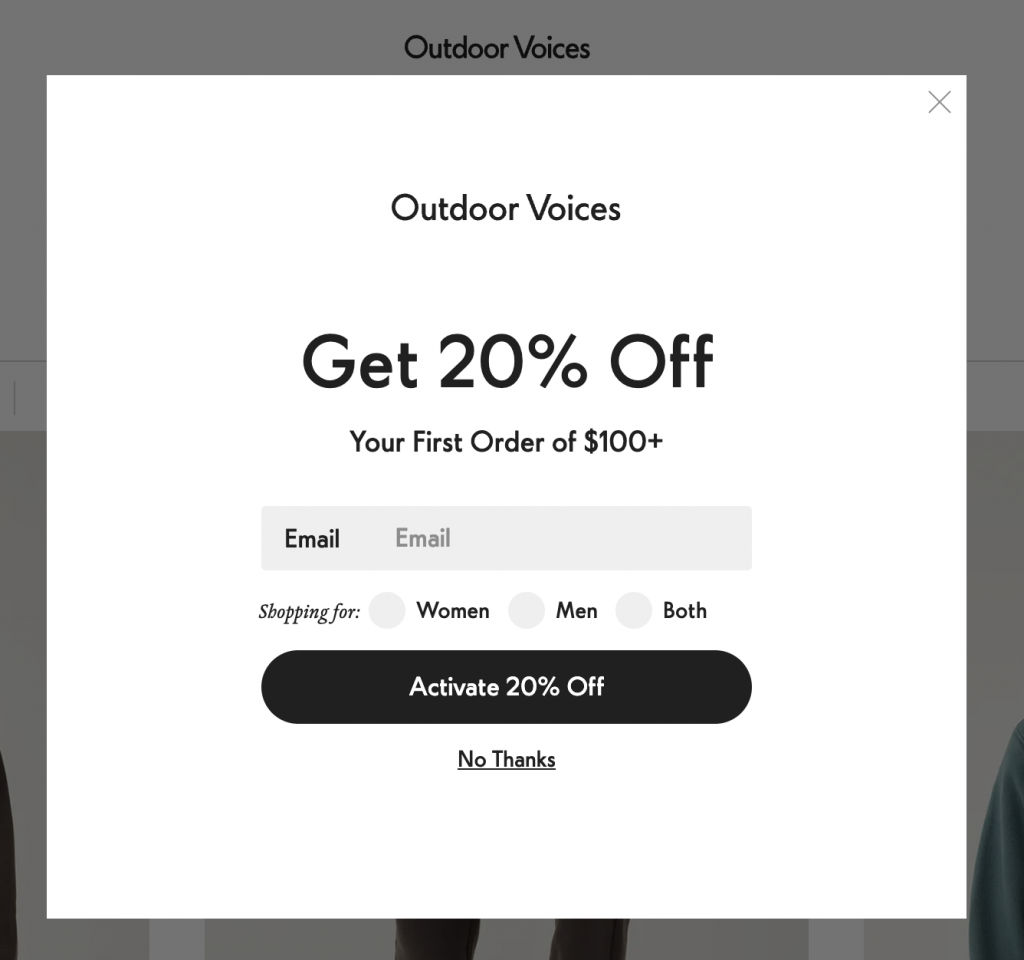With online shopping holding steady at record-breaking rates, here’s how you can connect with your customers and crush Q4 goals.
Here, you’ll find:
- Predictions for 2022 EOY sales
- How to make your holiday e-commerce ads stand out
- Ways to optimize your website for peak performance
- Why audience targeting will be especially key
I know, I know — you’re fully in autumn mode making Halloween plans and Googling the nearest pumpkin patch, and here I come talking about holiday e-commerce marketing and end-of-year goals.
But just because it’s not yet time to swap your PSL for a gingerbread latte doesn’t mean you shouldn’t be thinking about the upcoming holiday shopping season.
Last year saw the largest annual-growth leap of the past decade, according to the National Retail Federation. But with supply chain issues not fully resolved and more active e-commerce businesses operating online stores than ever before, you’ve got to get creative — and strategic — to connect with your customers and successfully beat the competition during this time of the year.
Getting your holiday e-commerce marketing initiatives in order now, before the winter rush, can keep you more organized as we barrel through Q4, while taking some of the stress off you and your team. Let’s get into it.

A holiday email from clothing and accessories brand ASOS. (Image: Printful)
Holiday shopping 2022 predictions for marketers
A data-powered forecasting report from Salesforce highlights key holiday shopping predictions, and marketers would do well to take notes. Among the important takeaways:
- While U.S. online sales will likely remain well above pre-pandemic levels, they’re unlikely to surpass 2021’s
- Increasing prices may mean fewer orders and tighter profit margins
- Sustainability will remain top of mind (more on that below)
- Shoppers plan to start early — that means before Cyber Week
Now that you know what to expect from these last few months of 2022, here’s how to turn that knowledge into action.
1. Create a personalized shopping experience
E-commerce stores can approach personalization in a handful of ways. Of course, there’s remarketing, wherein you retarget visitors who have previously viewed an item or even put it in their cart but abandoned it before checking out.
If you can make it happen, October is the perfect time to ramp up your prospecting ads, especially if your products have a relatively longer purchase consideration period. This way, your retargeting pools will be primed and ready for purchase when the holiday e-commerce promos kick into high gear.
Some apparel brands will have a pop-up on their site letting the visitor choose the category or size they want to browse for, helping them narrow their options and create a more customized shopping experience.
You can also leverage heatmapping or page journey tracking (or what Google calls flow visualization) to follow a customer’s cursor at every stage of the shopping process through checkout.
Not only can this help you identify strengths and weaknesses on your site (like design issues affecting customer experience), but you can use these details to reveal different information and products to customers based on their browsing history and content interaction.
Pro tip: Add a call to action (CTA), reduce page length, or insert an exit-intent popup to help engage potential customers more effectively.
2. Prioritize customer service
As the number of shoppers and purchases increase, so do the questions. You don’t want to run the risk of an unhappy customer — or a negative online review.
Especially since we know that research shows it’s cheaper to retain existing customers than attract new ones, e-commerce customer service is especially important around the holidays.
Here are just a few FAQs to be prepared for:
- How many days does it take to ship a product out?
- Do you offer gift cards?
- Are there any additional promos or deals going on?
- Will my purchase be here by the holidays?
- How can I find or track my purchase?
- What’s your return policy?
Live chat and automated chatbot options can often help answer common questions or link new customers to a frequently-asked questions page. You can also consider outsourcing after-hours phone calls to a virtual assistant service provider.
Speaking of FAQs, make sure this page is updated with all the necessary information shoppers might wonder about. You don’t want broken links or outdated info, since this will just frustrate your customer and could lead to the dreaded cart abandonment.

Athletic apparel brand Outdoor Voices offers a discount in exchange for signing up for emails and lets shoppers personalize their shopping preferences. (Image: Outdoor Voices)
3. Create holiday email campaigns
Email is one of the most effective digital marketing methods you can leverage, so it’s certainly worth a spot in your holiday e-commerce marketing plan.
While Black Friday may get lots of hype, Cyber Monday drives billions of dollars in sales each year. Email marketing that highlights holiday promotions and offerings can be a great way to boost sales. But to stand out in an overflowing inbox, you’ve got to get creative.
When crafting your emails, we recommend you:
- Keep the message short and include eye-catching, themed visuals
- Create a “holiday countdown” email that tells recipients how much time they have left to place an order for overnight delivery, free shipping, etc.
- Always include a clear CTA that leads back to a landing page on your site
- Add a limited-time offer (LTO) — customers are more likely to take action when they know the deal won’t be around for long
- Segment your email lists so you can send the most relevant products to each group
- Optimize for mobile, as the percentage of people purchasing straight from their phone continues to rise
Is your company participating in any philanthropic initiatives during the holidays, such as Giving Tuesday in November? Whether it’s donating to a nonprofit organization or volunteering, highlight this in your email. Consumers tend to favor brands that give back over those that don’t.
Pro tip: Some brands create holiday promo landing pages ahead of time. They use these pages to generate more sign-ups for their email list with CTAs like “Get alerts when our Black Friday deals go live.”
4. Use assets and sitelinks
Because pay-per-click (PPC) campaigns encourage targeted traffic, they’re on the top of most e-commerce brands’ wish lists. When your company ad comes up, you can give customers the option to click on sales products, special holiday gifts, bonus offers, and similar promotions.
Using ad extensions (which Google recently rebranded as assets) and sitelinks lets you add more context to the ads you publish. When a brand is searched for on Google, sitelinks can appear below the ad’s main URL.
Similarly, Google Ads can include assets that provide more info about whatever your ad is about through copy.
These sitelinks and extensions reduce the amount of work shoppers have to do, which can encourage them to click the link. You can also use review ad extensions to mention price reductions, special holiday shipping information, and more.
5. Focus on video marketing
Video ads on platforms like YouTube, Instagram, and TikTok can produce better results than a text advertisement in some instances.
Especially when it comes to social media, the younger (and powerful) generation of shoppers today mostly prefers video ads. So it’s no surprise this type of ad can be a better way to engage consumers, especially through user-generated content (more on that below).
Along with paid ads, you can leverage video content throughout your site to boost search engine optimization (SEO) as well. These videos could show your apparel on a variety of body types or walk viewers through the easiest way to set up and use your product.
When publishing SEO-minded video content, it’s helpful to keep best practices in mind, such as:
- Adding captions
- Optimizing titles and descriptions
- Creating a video sitemap
- Exploring rich snippet SEO for videos
- Choosing the right hosting option

Clothing brand Madewell allows you to shop via their Instagram posts. (Image: Instagram)
6. Take advantage of UGC
User-generated content (UGC) is becoming a major driving force behind successful e-commerce marketing campaigns, thanks in big part to social platforms like Instagram and TikTok. (Just scan the #tiktokmademebuyit hashtag for proof — these videos have garnered nearly 25 billion views… and counting.)
Since the term’s meaning has been misconstrued lately, let’s break it down: user-generated content is strictly organic. That means it was created by a person not affiliated with or paid by a brand.
Brands can, of course, leverage UGC in their own marketing efforts, but this happens after the content was created. (Plus, the company often offers an incentive such as payment, free product, or a tag to the creator’s account.)
While UGC creators have grown in popularity in recent months, this type of content is technically sponsored and not organic.
Coupled with stellar online reviews, UGC can make a great case for your brand during the holiday season. If you get a notification that someone has created a video, tweet, or other content praising your brand’s product or service, it’s worth reaching out (or “dueting” the content if you’re on TikTok) to ask if you can repost.
Pro tip: Plan to launch your holiday campaign before Black Friday. Data shows Thanksgiving Day and Cyber Monday are actually the fastest-growing days of cyber week for holiday e-commerce sales.
7. Explore influencer marketing
If you haven’t done it yet, the 2022 holiday season is a great time to start exploring partnerships with influencers in your industry. If this is your first influencer rodeo, you can look into micro- and nano-influencers first.
According to Forbes, micro-influencers (those with follower counts in the lower thousands) have a 60% increased engagement rate and a 20% higher conversion rate than their counterparts with more followers.
Micro-influencers are often more affordable, making it easier to market your products to your target audience without breaking the bank. As a bonus, the engagement rate for influencers tends to rise during the holiday season.
8. Leverage social — and mobile
Online shopping through social networking platforms (aka social selling) continues to grow in popularity, according to Forbes. They also report that ordering and traffic shares skyrocket for online retailers during Christmas and Cyber weeks as compared to the rest of the holiday season.
It’s yet another reason why it’s crucial for your site to offer an equally pleasant and easy user experience on mobile devices like smartphones, tablets, and desktops.
Another great way to capture those who mainly search and scroll on their phones is by creating timely organic and paid social media marketing content. Explore all that m-commerce (that’s mobile commerce) and social selling have to offer — these budget-friendly tools can bring about big sales.
9. Focus on review sections
When 79% of shoppers say they trust online reviews as much as personal recommendations, you know they’re incredibly valuable. Online shoppers tend to pass over products with no reviews or too many negative ones.
You can beef up your credibility through your holiday e-commerce plans by adding review sections, making them more prominent on your product pages and paid search ads, or asking previous satisfied customers to provide reviews via an email campaign.

Retail and outdoor recreation services brand REI has a thorough section on their website detailing their sustainability practices. (Image: REI)
10. Ensure your site is speedy
Oh, what fun it is to shop on a site with an average load time of under two seconds! (…Right?) Experts note that most people will abandon a site if it doesn’t load within 3 seconds.
There are ways to minimize your site’s loading speed, but working with a developer or your existing dev team is your best bet.
You can speed up your website through actions like:
- Minimizing HTTP requests
- Compressing your site’s files
- Scaling down images
- Reducing server response time
- Enabling browser caching
11. Keep the eco-consumer (and the planet) in mind
As BigCommerce reports, there’s been a growing call from customers for more eco-friendly practices for brands. Customers value sustainability more and more — and it can affect a purchase decision.
Get creative with your holiday e-commerce efforts by highlighting any eco-conscious efforts you have at your company. If you don’t have any, it’s a good time to revisit the topic at the top of the year — and perhaps partner with an eco org or donate to an eco-benefiting nonprofit in the meantime.
Not only do sustainably-minded business practices benefit the future, but it can help give you an edge over less mindful competitors.
Consider (and, of course, follow through with) some of these ways to comfort shoppers concerned about the environmental impact of their purchases:
- Biodegradable or compostable mailer sleeves
- Creating products with recycled materials
- Recycled packing materials
- Eco-friendly package transportation
- Mailing a multiple-item order in as few packages as possible

Cosmetics brand Estée Lauder offers live chat and video options on their site.
12. Consider AR & VR
One of the biggest hurdles to online shopping is that you simply can’t gather as much info about a product as you can in person. This includes what a color looks like in different lights, how a fabric feels, or the quality of material.
More and more brands are working to mitigate this through augmented reality (AR) and virtual reality (VR). Think: a virtual fitting room (as Shopify suggests), an eyewear brand that lets you upload a selfie to “try on” different styles, or furniture purveyors who let you digitally add their products into an existing photo of your living room.
If it makes sense for your brand, budget, and audience, adding these virtual elements to your holiday marketing strategy could bring about impressive returns (as in ROI, not refunds.)
The takeaway
The holidays should be a time of cheer, not a time to run yourself and your team ragged trying to keep up.
Having a solid holiday e-commerce strategy in place that maps out how you plan to handle this busy season can help you and your team push through together — and come out profitable in the new year.
This article has been updated and was originally published in November 2019.

